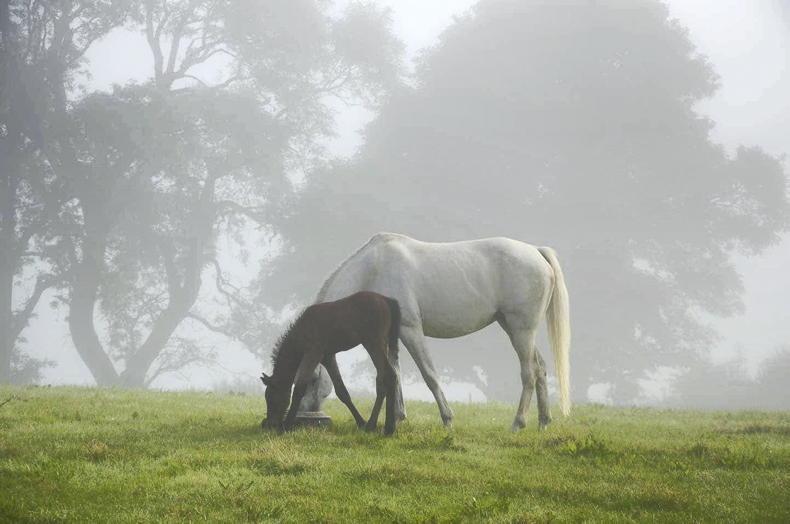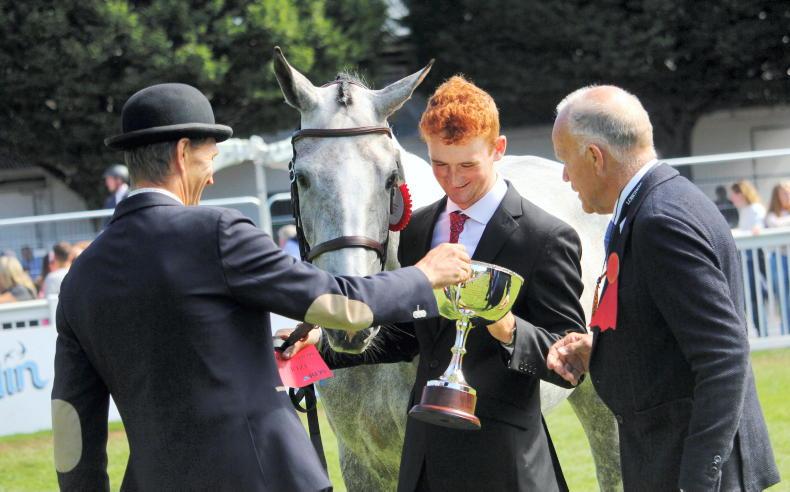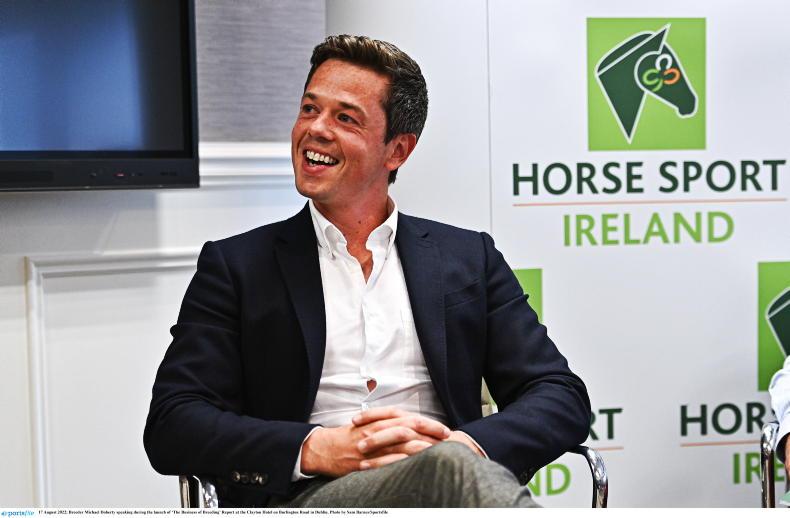SETTING out to establish a breeding programme in my 20s, I sought out successful breeders at very opportunity. I wanted to understand how the best did what they did.
These breeders were incredibly generous with their time and knowledge. So much inspiration in each conversation and farm visit.
In 2018, I created the podcast Big Talk For Breeders to capture these conversations, enabling others to benefit from them too. Each interview ends with the same question; “What advice would you offer to a young breeder, or someone at the start of their breeding career?”
Many guests spoke about the importance of the mare, advising breeders to start with a mare from a proven damline. While the importance of breeding with such mares has been well emphasised, to a degree, it only addresses the pedigree, or ‘paper’, aspect of broodmare selection.

Prior to first visiting several of these successful breeders, I expected to find that the dams of the sport’s top performers would be big, beautiful mares.
A picture of ‘the perfect mare’, so to speak.
Often, they did not conform to that picture in my mind. For a while, it left me thinking that these mares didn’t have much in common as individuals.
However, the more I listened and observed, the clearer it became to me that what I was looking for was often not to be found on the outside of these mares. To help complete the broodmare picture, I recently posed three questions to 10 successful breeders, all past guests of Big Talk For Breeders.
Q1 Throughout your breeding career, are there traits that many of your most successful broodmares have shared, external or internal?
Alan Waldman (Waldman Horses, The Netherlands): One of the biggest character traits I’ve seen on the better breeding mares is that they give their overview of how they study the jump, or how they leave the ground, and I think this comes through in their offspring. How careful they are, how smart they are, how they measure what they do, and if they pat the ground, back up, or jump forward. I think that really comes through. Every mareline is different. They mature and show things in different ways.
But, what I’m finding more and more important is, how those better mares view the jumps, how they back up, being brave and careful at the same time, and how that comes through [to their offspring].
Andrew Hughes (Ennisnag Stud, Ireland): Good mind, jump and blood.

Bernard Le Courtois and Michael at Haras de Brullemail
Bernard Le Courtois (Haras de Brullemail, France): The most important things are the bloodlines, damline, and ability. Conformation is not so important, as long as the mare doesn’t have big conformational faults.
I had several foundation mares who were very different in type, size, blood, conformation, and damline. They all shared one common point. They were daughters, or granddaughters, of my stallion Alme.
Fred van Straaten (Family van Straaten, The Netherlands): In every way, the broodmare should be a future sport horse.
Gerda Stoop & Walter Van Bunder (Stud Merelsnest, Belgium):
Enough blood, but good to
ride. Good conformation. Strong back and well functioning hindquarters. Powerful. Good technique while jumping. Nice character. Good X-rays. Healthy.
Ilse Bosch (Gebr. Bosch - The Netherlands): Blood. Hard
and dry legs. Good gaits. I like to see them accelerate, and make easy changes in canter.
Isabelle Van Eeckhout (Stal d’Ive, Belgium): The characteristic that I think is the most important for breeding is the mentality of the horse. You cannot see it on the outside, but it is on the inside of the horse. I have big mares, small mares, beautiful mares and sometimes not so beautiful mares. But, what they all have is this will to work, they love to jump. I don’t mind if they have a mind of their own, but when they see a fence, they only think about jumping, because they really want to.
I think that scope and size are more stallion characteristics to pass on to a foal, and that intelligence and mentality are coming from the mare. Also, mentality is something that can be improved, or ruined, by a rider.
They can ruin a mentality by always punishing, or going too fast with young horses, especially mares. If you build them up by rewarding, and never letting them do something they are not capable of, it improves the mentality.

Jan Greve (De Watermolen, The Netherlands): The good mares all go back to successful families, even before sport. Horses with a positive instinct, and good attitude, that want to work with you. They have to want to cooperate with you.
Paul Hendrix (Hendrix Horses, The Netherlands): The most important trait is the willingness to be successful. That’s something you cannot see on a pedigree. It’s the internal quality. The willingness of a horse to be successful, at whatever level, that’s important.
Tom Brennan (Mill House Stud, Ireland): Our mares were retained based on what our good client, Max Hauri, looked for. We were sticklers on a very proven family, and then good movement in trot, straight, with good extension. As Seamus Hughes would say, “All you had to do was listen, and you’d hear the rhythmic step”. This trait made the progeny adaptable to all equestrian spheres. Good lookers, and show athleticism at the jump.

Michael with April Moon and her Cornet Obolensky filly foal
Q2 When selecting younger mares for your breeding programme, what are the essential traits that they must have, or demonstrate, before you will breed from them?
Alan Waldman: It’s really important that they are correct. For soundness, that they have good feet, and are strong movers. Not weak horses. That they have a good way of jumping. It’s important that they have a good pedigree, or a pedigree that I like.
That’s subjective. If you are going to breed younger mares, you want them to be as complete as possible before you start.
Meaning that size is good, they are correct, have good X-rays and jump in a good way, because you don’t always have as much information about riding them. Certainly, if you choose from a good family, you have a better chance that they will breed well.
Andrew Hughes: Blood, jump, and good X-rays.
Bernard Le Courtois: Sometimes, I make an embryo transfer, or breed some three-year-old fillies. They must have good conformation, jumping talent, and a top damline.
Fred van Straaten: Correct conformation, strong hind leg, and the ability to use her body in the right way. Observation of the filly during the raising, from foal to three-year-old, is an interesting process. How is she in the group? Is she electric, quick and smart, or slow and dumb? How is she out of the group? In her free jumping? And, of course, is she clinically okay? Are the X-rays good enough?
Gerda Stoop & Walter Van Bunder:
Blood. Rideability. Good conformation and character. Powerful. Good technique. Good X-rays. Healthy.
Ilse Bosch: Quick, and show blood. Don’t stumble over a pole on the ground. Have an honest character.
Isabelle Van Eeckhout: I love the filly who, when there is a new situation, will always check and say to the others “come on, let’s do this”. Passing through water, a new fence, etc. So I know they have the right mentality to learn. When we free jump them, I love when they always jump, and the ease with which they use their body. It doesn’t always have to be ‘wow’, but they should use their body in a way that they don’t have to think about what they are doing.
Before future breeders begin, they should think about what they would love to breed. Do they like a big scopey horse, or maybe the opposite? Do they prefer the little fast warriors?
Then, they can choose a mare that looks most like what they want to achieve.
Jan Greve: The family. I only select from the families that produce good sport horses. They must have the things that we like and need; quickness, scope, elasticity in the body is very important.
The mind is important. The main job of a horse nowadays is to please people. You have to look to see if they have the ability to do the job that you want them to do.
Buy the best mare that you can afford. It’s better to buy a lesser mare (a normal type, small, less attractive, etc) from a good family, than a nice one from a bad family.

ET, a filly by Tangelo van de Zuuthoeve out of April Moon
Paul Hendrix: If the offspring are there, you know that willingness, internal character and attitude is there, because these are the bloodlines that you have chosen to go further with.
Then, you like to see that they have a good type, good balance and jump better than average.
That’s when we decide to breed them, before their [sport] career. The ones who stand out the best from each year’s crop, we breed with.
Tom Brennan: Proven family, good movement, looks and jumping reflexes. Good working temperament, and kind.
Q3 What are the traits that you will not accept in a potential breeding mare?<
Alan Waldman: That’s hard, because you always have a list of things that you don’t want to breed with, but you make compromises sometimes, and still use it.
For me, the hardest thing in breeding is soundness, so it’s really important that you start with a sound mare.
A mare that is strong, moves well, and was able to do the sport for a long time, or gave a really healthy impression. It’s different from a mare that gets hurt because of a tendon.
A lot of these really weak horses, they start off weak in one place, and then it goes in another direction. You want to begin with a horse that has a strong foundation.
Andrew Hughes: You can breed most things out of them with good stallion selection, but things I don’t like are a bad hind leg, and plain.
Bernard Le Courtois: I never breed from a mare with a very poor pedigree, or ugly conformation (very bad back, hocks, legs) which she could transmit to the foal.
Fred van Straaten: When the mom is under the saddle, and not showing the right quality, we won’t breed with her daughters.
This is our system and, up to now, it works well for us.
Gerda Stoop & Walter Van Bunder: We will not accept bad X-rays, unhealthy, poor conformation, bad character, technique or movement.
Ilse Bosch: Nasty character. Horses that don’t improve after making a fault. I do give them time to show, or improve.
If mares don’t produce what we like after several foals, we sell. Luckily, our programme is so developed, that I can’t remember when we last had this. The feeling you have with a horse is a big part of it.
Sometimes you can’t say something wrong about it, but you just don’t feel it. And sometimes there is something to say, but you still like them a lot. I like to give them a chance to prove themselves then.
Isabelle Van Eeckhout: Sometimes people say, “there was always something with the mare on the show. She was lame, had this, then that, then she stopped, so now we breed from her”. I would never do that.
When I was young, I read an article from an older Holsteiner breeder.
He asked which mare would you prepare for the shows, and which one would you breed? This was before embryo transfer. Most people said, “I would take my best mare to the show, so we can sell and make money”.
He said: “You have to breed with your best mare, to always improve. If you breed with your lesser mare, you will always have lesser horses, and in the end, you won’t have any good horses to go to a show with.”
Jan Greve: Big conformational issues. A bad mind, that they don’t want to do anything. If they don’t have enough elasticity, I don’t want them. If they find things easier to do, then their mentality will most likely be better.

Jean-Luc Dufour and Jan Greve present Patrick Doyle, leading Lorraine MacGuinness’ Gone Girl VB, winner of the Horse Sport Ireland Broodmare Futurity class \ Susan Finnerty
Paul Hendrix: More and more, you also want soundness in your mares. What I have learned is, the ones who fall away very early with injuries, you quite often see it back in the second and third generations.
So, you like to have a certain soundness in the horses. That does not have to be particularly on X-rays, but that they were able to succeed in the sport for several years.
Tom Brennan: I always joke, but I am serious behind it. It’s like a single guy in a bar, noticing a particular girl. It’s up to each individual, and their choices.

Tiernan Gill and Paul Hendrix pictured at the IHB conference \ Laurence Dunne Jumpinaction.net
Conclusion
As breeders, we often seek out patterns, or clues, to guide our decision making, be it in terms of pedigrees that cross well, up and coming families, young stallions, and so on.
Each successful breeder might have their own approach, but the patterns are there for us all to see.

Young stock at Ennisnag Stud in Co Killkenny
Michael Doherty’s Big Talk For Breeders is available on Apple Podcasts, SoundCloud, Spotify or by visiting www.michaeldoherty.ie/bigtalk
